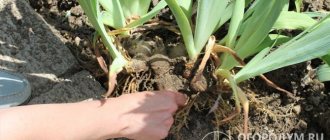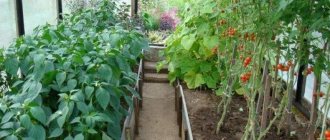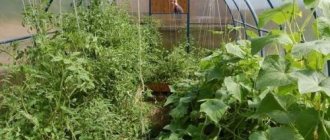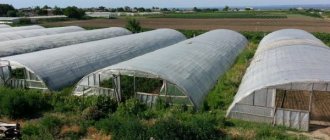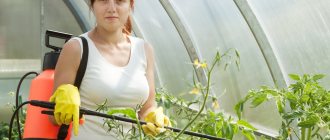What kind of greenhouse should it be?
A greenhouse for growing flowers can be either very small or quite impressive in size. A special type of greenhouse is winter gardens, which are quite popular among owners of country houses.
Any greenhouse in which it is planned to grow flowers has a number of requirements:
Greenhouse for year-round flower growing
- Greenhouses for growing flowers must be installed on a foundation. (See Greenhouse Foundation)
- The design of the greenhouse must be sufficiently strong and reliable.
- The greenhouse covering must be multi-layered to prevent drafts, which are destructive for most flowers.
- The heating system must be combined, that is, not only heat the air, but also warm the soil.
- An additional lighting system if you plan to grow flowers in greenhouses all year round.
- A properly organized control system:
- air and ground temperature;
- air humidity.
Greenhouses for growing flowers are set up depending on what type of flowers are planned to be grown. Based on the flower crop intended for cultivation, the greenhouse is divided into beds for subsequent planting of plants in the ground, or a system of multi-tiered shelving is installed.
Shelving in a greenhouse
Racks, as a rule, are built with a height of 80 to 100 cm, the width of the side ones is 100-110 cm, and those installed in the middle are 200-210 cm.
Shelving is made from metal or reinforced concrete, trying not to use wood, since it breaks down quite quickly and is also quite difficult to disinfect.
Racks can have both high and low sides. So, for growing potted plants, make low sides of 2-3 cm, and for rooting cuttings or planting plants, make high ones - 25-30 cm.
The space under the shelves used in the process of growing flowers in greenhouses can be used for storing planting material: bulbs, rhizomes and tubers, and can also be used for forcing various bulbous plants.
Greenhouse dimensions
How to determine the size of the structure
The width of an ordinary greenhouse rarely exceeds five meters. As for the length, it can be any, and no special restrictions are provided. In most cases, flower growers are limited to building greenhouses 15-20 meters long, stretched along a west-east line. Creating such a greenhouse with your own hands is not at all difficult.
Note. It is noteworthy that there are no special requirements for the northern side of the greenhouse - any material can be chosen for it, because the heating system will not depend on it.
Peculiarities:
- The north side is best suited for placing a special vestibule for storing inventory and equipment.
- The principle of operation of the greenhouse itself is almost the same as that of a thermos - several polycarbonate layers are used, between which a thermal layer is formed.
The frame of the structure must contain a number of ventilation holes, through which the entire internal volume is uniformly heated.
Planting and caring
As a rule, the business plan provides for planting about 4 rose bushes for every square meter of the greenhouse. If necessary, provisions should be made to reduce this amount by half for the next year.
Roses are those flowers for which good lighting is especially important. That is why the soil cannot be covered with sheets or anything else. The humidity in the greenhouse should be kept around 70%. The greenhouse structure must be ventilated daily, and the beds must be weeded regularly. Flowers should be carefully monitored in order to detect the presence of diseases in time. Having found affected plants, they should be removed as quickly as possible.
What flowers can you grow?
A wide variety of flowers can be grown in greenhouses, both for cutting and as potted crops. Most of the flowers grown in flower greenhouses are kept there throughout the year; these are flowers such as carnations, various orchids, carnations, and chrysanthemums. Some plants grown in greenhouses are intended for subsequent planting in open ground, and are only temporarily kept in it.
It should be noted that flowers grown in a greenhouse or greenhouse are much stronger and well developed, in contrast to the same plants grown in open ground.
The most commonly grown cut flowers are:
Roses blooming in a greenhouse
- roses:
- hybrid tea;
- floribunda;
- grandiflora;
- miniature;
- carnations:
- garden;
- multi-flowered;
- Chinese;
- tulips;
- daffodils;
- crocuses;
- gerberas;
- peonies:
- herbaceous;
- tree-like;
- asters;
- dahlias;
- daisies;
- violets;
- chrysanthemums.
Various orchids, palm trees, cacti, Saintpaulias and gloxinias, as well as other exotic plants such as pineapples and bananas, are grown from potted crops.
Orchids grown in a greenhouse
What about finances?
Your plan must contain expenditure and income components. That is, you must provide the necessary minimum funds to open your business. This minimum will include the amount required for the construction of greenhouses; it is calculated based on the total footage of all structures.
The next expense item is the purchase of reliable, high-quality seedlings (for example, 200 rose bushes). Then - purchasing fertilizers and necessary additives for the soil. Additionally, heating costs for each greenhouse should be included.
Adding everything up gives us the total amount of money required to grow each cycle of flowers throughout the year. The expected result will be approximately equal to the number of cut roses, equal to or slightly less than the number of planted bushes (adjustments must be made for inevitable losses). Knowing the market prices per unit of flower products, you can easily calculate how much all your roses will be sold for.
By comparing the estimated income with the amount of expenses calculated above, you can determine and plan the level of net profit. Income from growing flowers can be very, very good, especially if you gradually increase the number of greenhouses, expand the range and find new customers. If everything goes well, you will soon need hired workers, and you will be able to expand your business.
At the same time, you can grow indoor plants in pots or, as already mentioned, medicinal herbs. That is, the range of goods produced by your greenhouses can be practically unlimited. If the business is successful, after a while you can even afford to open your own flower shop.
Conditions for growing flowers in greenhouses
What kind of soil is needed
Any of the flower crops has special requirements for soil fertility and quality. Successful cultivation of flowers in greenhouses largely depends on how correctly the soil for planting is prepared, taking into account the characteristics of the plants.
To maintain constant high fertility of the soil used in flower greenhouses, as well as improve its quality characteristics, a number of measures are carried out:
- fertilization with various types of manure; (See also Fertilizing Tomatoes)
- mulching;
- weed removal;
- loosening.
Loamy and chernozem soils are considered the most favorable for growing flowers in a greenhouse. Loam is able to easily pass water and air through itself, and in addition, it is able to retain nutrients. Chernozem soils contain many nutrients and microelements that are so necessary for flowers in a greenhouse.
Soil preparation in a flower greenhouse
An important stage in preparing the soil for subsequent cultivation of flowers in greenhouses is digging up the soil. Most flower crops have a fairly deep and developed root system, for which it is necessary to prepare a good cultural layer of soil.
Important: you should not plant perennial flowers in greenhouses, the foundations of which are superficial and cannot provide the plant roots with normal conditions for development and growth.
Growing flowers in greenhouses requires digging up the soil. The digging depth before planting annual plants is 25-30cm. If the soil is being prepared for subsequent planting of perennial flowers, you need to dig deeply, in some cases up to 1 m.
As a rule, digging is combined with the application of complex mineral and organic fertilizers.
What fertilizers and when to apply?
All flowering plants require different nutrients. In this regard, there is a need to add mineral and organic substances to the soil.
As mentioned above, when digging, organic fertilizers such as compost or humus are added. Experts also recommend filling the soil in the greenhouse with mineral fertilizers such as ash and superphosphate. Regardless of the type of soil, 200 g of ash and 80 g of superphosphate are added for every 1 m2.
It should be remembered that some types of flowers require special doses and special fertilizers to be added to the soil before planting.
It is necessary to regularly add various fertilizers to the soil, since it is almost impossible to grow flowers in a greenhouse, in the specific conditions of closed ground, without fertilizers.
For normal growth, development and flowering, all flowers need regular feeding.
Annual flower crops need to be fed two to three times per season. The first feeding is usually carried out 14-20 days after planting in the greenhouse. The time for the second feeding comes closer to the middle of the flowering season.
To fertilize annuals, use an aqueous solution of mullein, which is diluted in a ratio of 1 to 4.
Perennial plants growing in one place for several seasons are fed in three stages:
- Spring feeding.
- During the budding period.
- In the last days of flowering.
Fertilizers for perennial flower crops should contain nitrogen, phosphorus and potassium. In the spring, plants are fed with nitrogen-containing fertilizers, during the formation of buds - with potassium-phosphorus fertilizers, and at the end of the flowering season - with potassium-containing fertilizers.
What are the advantages of such work?
1. You are not limited by time - you can grow flowers all year round.
2. Focusing on the holiday calendar, you can prepare larger quantities of goods by certain dates to increase profits.
3. This business does not have a very long payback period and is not considered high-cost. Profit is possible already in the first year of doing business.
4. Standardized working hours are not important here, and a businessman can freely plan his time.
5. Along with flowers, you can grow medicinal plants, which are sold in pharmacy chains and pharmaceutical factories.
If an entrepreneur grows flowers on his plot of land, then he does not need to leave his home and go to work every day. Buyers will pick up the goods themselves - usually these are resellers or various small firms.
Caring for plants in a greenhouse
Flower crops placed in closed ground conditions and forced to grow and bloom in unusual seasons and times require constant care and attention from humans.
It is necessary to water and weed flowers in greenhouses, loosen the soil and remove weeds, monitor and regulate the temperature and humidity of the air and soil. Many types of flower crops require special, specific conditions.
Advice: you should not plant flowers with different needs next to each other. So, it is better to place drought-resistant and moisture-loving plants in different places in the greenhouse.
Now about the benefits
On the other hand, it can be easier to install an already purchased greenhouse due to the exact dimensions and identical sizes of all arcs and other elements. This point often becomes a stumbling block when constructing a greenhouse structure yourself.
Why are polycarbonate greenhouses so popular these days? Upon closer examination, glass structures, and especially polyethylene greenhouses, are inferior to polycarbonate. It does not break, which compares favorably with glass; such greenhouses can be repaired and moved from place to place. The material effectively stores solar heat, it is easy to give it any shape, its sheet can be cut even with a simple knife. Having stocked up on polycarbonate sheets, you can create a structure of almost any shape with your own hands, if you have the necessary skills for this task.
How to grow flowers in a greenhouse?
Growing flowers in greenhouses is not as popular as in greenhouses. Most gardeners who come to their plot only on weekends do not use greenhouses for flowers, but grow only seasonal vegetables in them.
However, there are also gardeners who use the greenhouse to its full potential:
- in early spring to obtain seedlings of various ornamental annuals;
- in summer for growing spicy herbs and various vegetable crops.
How should you prepare a greenhouse so that the flowers feel comfortable: develop and delight you with their flowering?
How to make a cold greenhouse?
For those gardeners who cannot visit their plot often, you can grow flower seedlings in a simple cold greenhouse. This structure can be built by anyone who knows how to use a hammer.
Cold greenhouse
A cold greenhouse consists of:
- a box (box) standing on the ground;
- a translucent roof, which is a non-woven covering material fixed to a frame, or a thick, reinforced polyethylene film.
Such a greenhouse for flowers, and not only, is suitable for those owners of their own homes who have not yet installed or built a stationary greenhouse or greenhouse.
If you have the opportunity, stay on the site for a long time, or you live in your own house, then you can arrange a special double shelter in such a greenhouse. To do this, you will need arcs that are installed inside the greenhouse and covered with non-woven material.
Important: if your greenhouse is covered with film on top, and arcs covered with non-woven material are installed inside, it must be periodically ventilated so that the plants do not suffer from carbon deficiency.
The simplest and most affordable cold greenhouse is simple wooden boxes, which are covered in two layers of thick non-woven material. Usually they are made about 45-50 cm wide, and about 20 cm high. Any length can be made, depending on the number of seedlings that are supposed to be grown.
Such boxes are installed with the ends oriented north to south, in a well-lit place, preferably protected from the wind.
In the future it is necessary:
- Fill half of the seedling box with prepared soil.
- Make grooves in the soil and pour them with a hot solution of potassium permanganate.
- After the soil has cooled a little, you can sow the flower seeds.
- When sowing is completed, the boxes are covered with non-woven covering material.
Tip: be sure to secure the covering material on the north side of the box, for example, with a lath. On the south side, it is enough to simply press it down with something heavy, for example, several stones.
- The material should lie freely above the ground; there is no need to tighten it.
- Watering is carried out through non-woven material, as it allows water to pass through well.
- After germination, the covering material must be pulled over the box.
Caring for seedlings that grow in such greenhouses is very simple. It is necessary to carry out periodic watering combined with the application of fertilizers.
An important advantage of such small greenhouses is that when precipitation occurs, moisture easily passes through the non-woven material, and there is no need to ventilate them, since the air circulates well.
This option of growing seedlings of flower crops in a greenhouse is most suitable for those gardeners who cannot visit their plot more than 1-2 times a week.
However, there is one “but” - such a flower greenhouse is only suitable for growing cold-resistant plants, or for relatively late planting.
How to make a warm greenhouse?
In a wide variety of climates, it is possible to create a warm greenhouse in which both flower and vegetable crops can be grown much earlier than in conventional cold greenhouses.
In order to make flower greenhouses suitable for early cultivation, you need to:
- Beginning in the fall, carefully prepare the greenhouse:
- remove all plant debris;
- disinfect the soil;
- dig up the soil.
- In the spring, fresh manure is placed in the greenhouse, which is well compacted and poured with hot water.
- A layer of humus, 15-20 cm thick, is placed on the compacted and spilled manure.
- A thick film is attached to the previously prepared arcs.
Important: the film must be at a height of at least 120 cm from the soil surface, since with a smaller distance from the film to the ground, the seedlings in the greenhouse may burn.
- After a few days, when the manure begins to actively give off heat and release carbon dioxide, you can plant seeds of various plants for seedlings.
Sowing flower seeds in a greenhouse
Growing flowers in a greenhouse with seedlings is not much different from growing the same seedlings at home - on a windowsill. The most important difference is that some plants, especially heat-loving plants such as petunias, celosias, ageratums, and other “southerners,” require additional shelter when grown in a greenhouse.
Both heat-loving flowers and any other annuals are planted in flower greenhouses as follows:
- The area where the seeds will be sown is leveled and marked in accordance with the planting pattern recommended for a particular plant.
- Special grooves are made into which the seeds are placed.
- Seeds that are not covered with soil, such as petunias, are pressed to the ground with the palm of your hand. The seeds of other plants are pressed to the soil and then lightly sprinkled with soil.
- After planting the seeds, the plantings are sprayed with water from a fine spray.
- Subsequently, all plants whose seeds are planted superficially are sprayed with a fine spray from a spray bottle.
- For plants with increased requirements for temperature and humidity, additional cover can be made by placing a non-woven covering material or a not very dense film on specially installed low arches.
In such favorable conditions, flower seeds germinate together. The most important thing is not to overdry the soil.
Thus, you can grow any flowers in Slava greenhouses, and then plant them in any place in your garden.
Documentation
To run a flower business, you need to take care of having the necessary permits. You can become an individual entrepreneur or cheat a little and take advantage of the advantages of being the owner of a private household plot (LPH). What's the trick? It’s simple: if you have a plot of land, and local authorities have documented that you are the owner of that same private household plot, you can avoid unnecessary expenses (including paying taxes, submitting an income tax return, etc.). Also, you don’t have to keep strict accounting records.
On a note! Although private household plots are very convenient financially, they also have a downside. You will not be able to sell flowers yourself, but only through resellers. In some cases this may not be economically viable.
An individual entrepreneur, although forced to pay taxes and closely monitor accounting, is still free to set prices and sell his products. To become a businessman, you need to go through certain stages.
Step 1. Register as an individual entrepreneur (state registration procedure).
Certificate of state registration of an individual as an individual entrepreneur
Documents for registration of individual entrepreneurs
Step 2. Select OKVED code. In our case, this is the one called “Ornamental Gardening” and subsection A – “Growing Flowers”.
Selecting OKVED code
To register an individual entrepreneur, fill out an application form P21001. When filling out sheet “A”, information about the types of economic activities is entered
Decoding codes
Step 3. As a taxation system, you must choose the Unified Agricultural Tax (USAT). His rate is 6% of all profits.
Unified Agricultural Tax (Unified Agricultural Tax) - replacement of payment of corporate income tax, VAT (except for the tax payable in accordance with the Tax Code and Labor Code of the Russian Federation) and corporate property tax and insurance contributions
Conditions for the transition to Unified Agricultural Tax
Step 4. Purchase everything you need to start a flower cultivation business.
After registration, you need to purchase everything you need to run your business.
Heating a greenhouse in winter
Heating system in winter
Heating is an excellent opportunity to grow flowers in greenhouses at any time, regardless of the season. In order for the greenhouse to perform its functions well in cold weather, the heating system must be properly installed. So:
- The installation price will depend not only on external conditions, but also on the features of the structure itself. For example, when using a polycarbonate coating, the thermal insulation will be better, which means less effort will be required for heating.
- To heat greenhouses, special stoves are most often used, which can be either stationary or mobile.
Advice. Stoves will be effective if they have good insulation, and this also applies to the floor. In some cases, for good insulation, you can additionally use polystyrene foam and some other materials.
Sales of goods
To make a profit from growing flowers, you need to sell your product.
This can be done in several ways:
- open your own flower shop;
- conclude an agreement with resellers;
- negotiate with the owners of flower pavilions;
- sell on spontaneous markets;
- make bouquets at home and sell them via the Internet.
Don't forget about the simple truth: advertising is the engine of trade. Therefore, do not spare money on this part of business development. Analyze the most effective advertising methods in your city and use them.
One of the main conditions for running a successful flower business is advertising.
Features of the lighting system
Care and lighting in the greenhouse
A greenhouse not only needs to maintain a stable temperature, but also good lighting (see Greenhouse lighting). On the other hand, it is important not to allow the lighting to be excessive. If necessary, you can use blinds to protect plants from sunlight.
Note. It is impossible not to take into account the characteristics of the plants themselves - each species has its own heat-loving indicators, and during the growth process they can change. To work at night, it would be a good idea to install good electric lighting.
Optimal greenhouse parameters
In order for flowers to grow well, they must be provided with constant care:
- Timely and sufficient watering.
- Periodic loosening of the soil, application of fertilizers.
- Protection from diseases and pests.
- Ensuring proper temperature and humidity levels.
More details:
- It should be noted that in any greenhouse for flowers, temperature and humidity are the most important criteria.
- Optimal values are in the range of 70-85 percent humidity. If the humidity is too high, this can lead to plant diseases due to the intensive spread of fungi.
- To regulate humidity, correction of irrigation intensity and ventilation (natural and artificial) are used.
If there is only one transparent wall, its location must be south. Plants will thrive with constant air circulation. This can be ensured, among other things, by maintaining the optimal distance between individual plants.
Choosing a location for installation
The site for the greenhouse plays an important role in creating the microclimate inside it. The territory should be open to sunlight, located away from bodies of water and accumulation of storm and melt water. If the site has already been formed, then finding the ideal place will be more difficult than at the beginning of its planning. If the relief surface has a hill, then it is preferable to install the structure there. If there is no natural hillock and it is possible to create it artificially, the greenhouse is installed where the slope is minimal. Such an area is artificially drained using a drainage system.
Experts advise positioning the greenhouse so that the entrance to it is on the leeward side.
It should be protected from drafts as much as possible. The structure may have a foundation. Such a structure cannot be moved to another place.

